Many people who grow Mandevilla are looking for dark glossy leaves and showy blossoms. Outdoors, the flowers attract hummingbirds and butterflies. Mandevilla grows fast, and the vines can grow quite long. Some Mandevilla don’t seem to climb as they should. You may be wondering, “Why is my Mandevilla not climbing?”
Buying a Mandevilla to grow as a climber and not having it climb is frustrating. This guide will help you find the problem and correct it if possible.
Table of Contents
Why Is My Mandevilla Not Climbing?
For Mandevilla to climb, you need two things. The first is a variety of Mandevilla that is a vine. Some types of Mandevilla are low-mounding plants. The second thing you need is appropriate support for the vine to climb on. If either is missing, the Mandevilla won’t climb.
Do All Mandevilla Climb?
No, not all Mandevilla climb. Wild varieties of Mandevilla are vines that climb anything they can use as support. Some newer hybrid Mandevillas form low mounds and are used as small bedding plants or hanging baskets. These hybrids do not climb.
Climbing Mandevilla Suggestions
Mandevilla ‘Alice du Pont’
This evergreen variety was one of the first commercially available Mandevillas. The vine can get to a height of twenty feet, although it is usually smaller indoors or in a pot. The leaves are large, glossy, and dark green. The flowers are pink, large, and trumpet-shaped.
Mandevilla ‘Laxa’
A woody, deciduous vine, this Mandevilla can grow to be 15 feet tall. The leaves are dark green with gray-green undersides. The flowers are white and have a gardenia-like fragrance that is quite powerful.
Mandevilla ‘Splendens’
Another evergreen, this vine is similar to ‘Alice du Pont’ but has pale pink flowers with dark pink eyes. As the flower ages, it turns into a deep rose color. The vines grow 10-15 feet long.
Mounding Mandevilla Suggestions
Mandevilla X ‘Madinia Deep Red’
This deep red Mandevilla is an evergreen that grows 12-14 inches tall and wide. It will be leggier and more vinelike in partial shade.
Mandevilla X ‘Madina White’
The white flowers of this Mandevilla have a yellow eye. This evergreen grows 12-14 inches tall and wide.
Mandevilla X ‘Madina Coral Pink’
Another hybrid developed by Madina, this Mandevilla also grows to be 12-14 inches tall and wide. The blooms are coral red with a yellow throat.
How Do I Get My Mandevilla to Climb?
In order to get your vining Mandevilla to climb, you will need to provide support. This can be a trellis, wall, or fence that is close to the vine. As the vine grows, it will naturally grab for support using tendrils. If you want to speed up the process, you can get stretch tie tape. This tape can be used to loosely tie the vine to the trellis or other support. The tape will stretch, so it does not constrict the vine and choke it. Never use wire as it won’t stretch and will eventually girdle the vine.
If you are sure you have a vining Mandevilla and good support for it to climb and the vine still won’t climb, the Mandevilla probably doesn’t have everything it needs to grow. Check the light, soil, water, fertilizer, and temperature.
Light
Mandevilla needs at least six hours of light to do well. Indoors, that light should be bright, indirect light. Direct sunlight can burn the leaves. Outdoors, place the vine in direct sunlight. If you live in a hot climate, make sure the Mandevilla gets afternoon shade.
Soil
Mandevilla will not grow well unless the potting mix or soil drains well. A potting mix for indoor plants will work well for containers. In-ground Mandevilla needs soils rich in organic matter, so spread some compost around the vine, then work it in the top few inches of soil. Be careful not to damage the vine’s roots when you do so.
Water
While established Mandevilla growing in the ground can handle some drought, potted plants cannot. The soil in a container dries out much more quickly than the ground. Consistent moisture will benefit in-ground Mandevilla as well as potted ones. Keep the soil moist but not soggy. A moisture meter is inexpensive and can be very helpful in preventing overwatering or underwatering.
Fertilizer
If your Mandevilla is in-ground, spread a fertilizer that is at least half slow release around the vine in the spring. For potted plants, use a water-soluble fertilizer that is formulated for houseplants and is high in phosphorous twice a week during the spring and summer.
Do not fertilize Mandevilla in the fall and winter.
Temperature
Mandevilla likes a temperature of 60-65 at night and 70-75 during the day when grown indoors. Keep the plant out of drafts and away from heating and cooling vents. Do not put a Mandevilla outside unless the temperature is reliably over 60 degrees at night.
Repotting
If your potted Mandevilla has been in the same pot and potting soil for over a year and is not growing well, it probably needs to be repotted. You can use the same pot but need to replace the potting soil. Even the best potting soil gets compacted and has a hard time draining when it gets old.
Climbing Mandevilla Ideas
Here are some suggestions for trellises and supports for your Mandevilla vine.
1) Bean Tripod
A tripod made for beans to climb makes a very effective support for a Mandevilla, too. Bean tripods are available at garden supply places and are not very expensive. You can choose from bamboo, wood, or metal, depending on the look you want and how much money you want to spend.
2) Porch Column
Use what you have and train your vine up the columns that hold your porch up. Use a variety of vine that has flowers contrasting with your house to make them show up better. When the vine dies back in the fall, peel the dead vine off the column and bring the pot in until the spring.
3) Lattice Against A Wall
A lattice can be purchased inexpensively to give a vine purchase when training it up a smooth wall. Paint the lattice the same color as the wall, use it without painting it, or paint the lattice in a contrasting color.
4)Create A Floral Mailbox
Create a living floral mailbox by training your Mandevilla up the post for your mailbox. Make sure your house number and the front of the mailbox are kept flower free, so you get your mail without a problem.
5) Traditional Rose Trellis
The rose trellis is a classic for a reason. With an elegant look, a trellis can be installed against any building to give your vining Mandevilla support while it climbs upward.
What Do I Do When My Mandevilla Vine Climbs Too High?
Sometimes vines go too high and climb on things they are not meant to climb. When the vine gets as high as you want it, simply pinch off the end of the vine. Pinching off the end of the vine has the added benefit of making the vine grow bushier and thicker.
Does Mounding Mandevilla Climb?
No, they do not. Most mounding Mandevilla top out at 14 inches, some as low as 12 inches.
In conclusion, if your Mandevilla won’t climb, make sure the variety you have is a vine. Provide good support and, if necessary, use stretch tie tape to tie the vine loosely to the support. Make sure you give your Mandevilla everything it needs to grow. If it still doesn’t climb, your Mandevilla may be a mounding plant that was mislabeled as a vine.
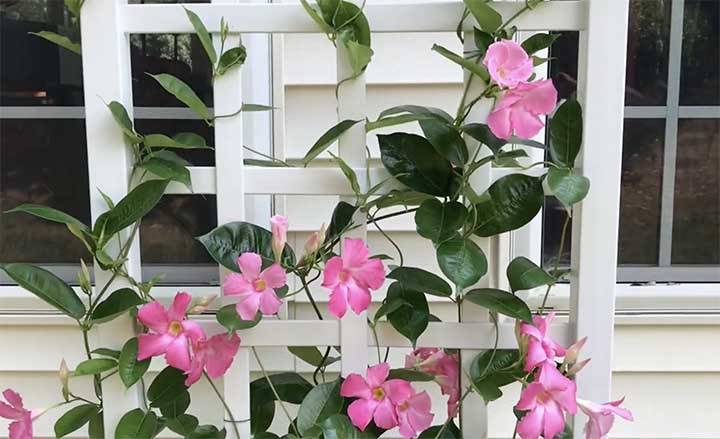
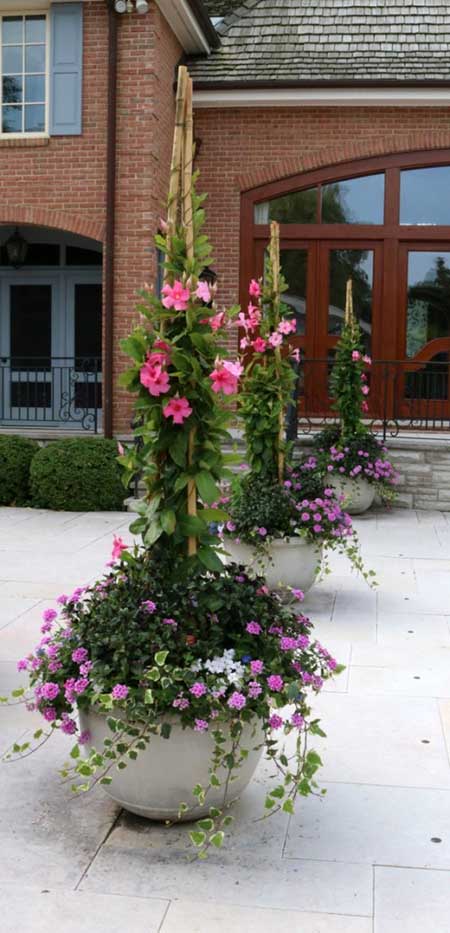
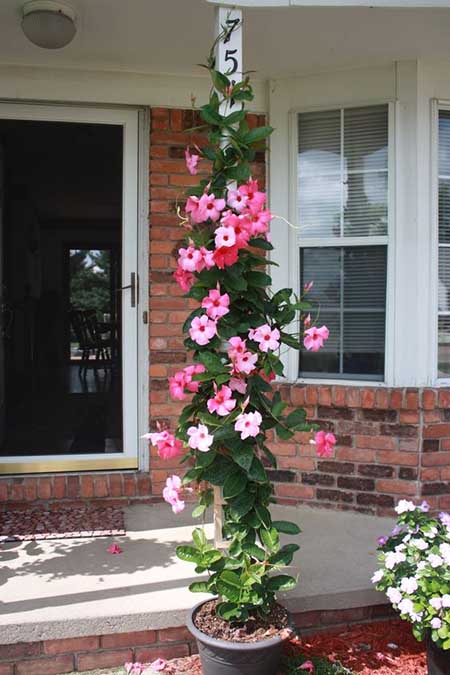
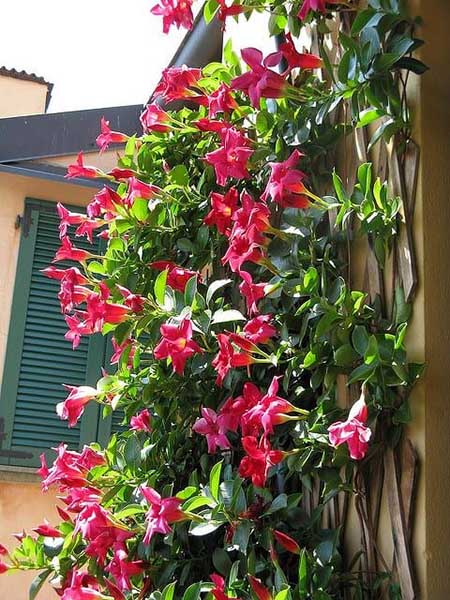
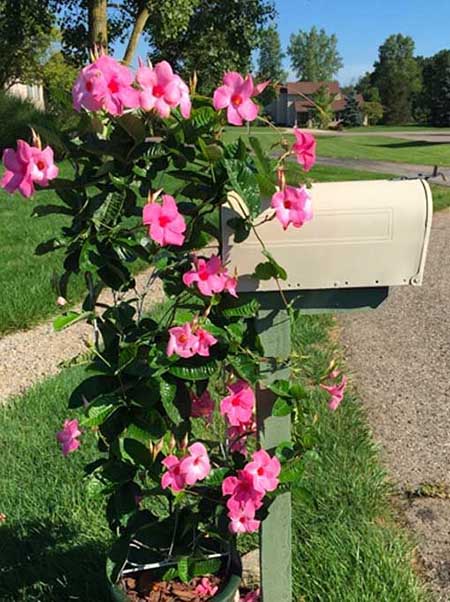
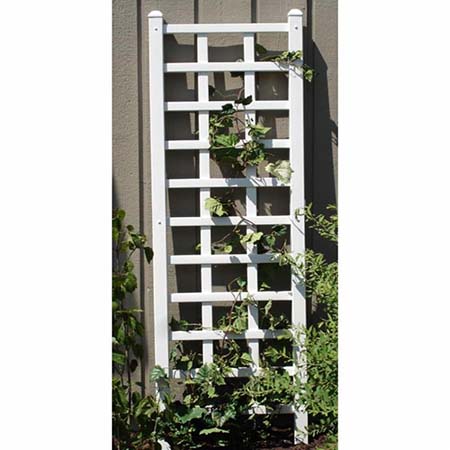
Awesome article thank you! Looking forward to following your vegetable blog 😊 Cheers from South West Aus.